|
Basic Tarantula Care
DISCLAIMER:
The information contained in this care sheet is not guaranteed to be 100% accurate or a governing rule of keeping tarantulas. Since there are many care alternatives, this information is based on my own experience and preferences. It is not intended to negate or argue other methods of care. It is always advised to seek additional information on the species you intend to keep.
HOUSING
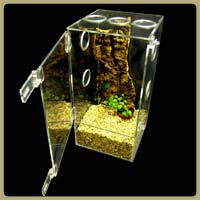
Choosing the proper housing for your new tarantula is very important in order to have a successful life in captivity. Things to consider are size of the container, ventilation, and height/floor space requirement depending on whether you have a terrestrial, burrowing, or arboreal tarantula. Other things such as substrate (the layer of medium on the cage floor i.e. vermiculite, peat moss, soil, or coco fiber) and furnishings will also play a part in the proper housing of your pet tarantula.
Cage Size
First, let's start with the size of the container. Spiderlings should be kept in a small container such as a clean sterile deli cup or plastic vial with holes punched in the lid for ventilation. Most spiderlings are acquired at a size of 1/4" to 1" in legspan. The best sized container for these spiderlings should be about 2" in diameter and 1.5" tall for terrestrial species (see photo below). For arboreal species, which need more height, a container 2" in diameter and 3.5" tall will suffice. For tarantulas 1" or larger, go with a container 4" in diameter and 2.5" tall for terrestrial species. For 1" or larger arboreals go with a container 4" in diameter and 6" in height.
Housing your spiderling in an appropriately sized container will greatly increase its chances of survival. Housing a spiderling in a container that is too large will cause the spiderling to be overwhelmed with with space, and less likely to catch prey. This can lead to poor growth and eventually death.
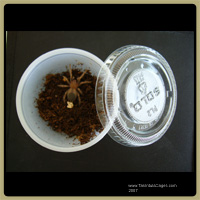
As your spider molts and grows larger, you can then gradually increase the size of its cage. Most species can be rehoused to something larger every 6 months to a year. At 3" or larger your tarantula is ready for a large cage, such as a 5 or 10 gallon tank or my Large Terrestrial/Arboreal cages.
Ventilation
Next, there is the ventilation factor. Ventilation plays a key role in humidity levels in your tarantula's habitat. Too little ventilation combined with too much moisture will result in a saturated environment, which can lead to mold/fungus growth and overly high humidity. Mold growth should be avoided because it can kill your tarantula, especially spiderlings. On the other hand, too much ventilation can lead to dry conditions and desiccation, which can inhibit proper molting. Spiderlings are very susceptible to drying out and dying without proper levels of humidity.
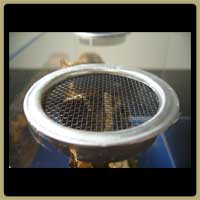
To add ventilation, simply punch holes using a thumbtack or other sharp tool. You can also use a fine tipped soldering iron to melt holes in plastic. For rigid plastic, you may use a hand held drill with a bit small enough to prevent escape. Screen tops can be partially covered with plastic wrap and tape to create a higher level of humidity.
Substrate
Choosing the substrate for your tarantula's cage is important and is subject to personal preference. The species being kept is also a factor when deciding on the substrate. Commonly used products are peat moss, horticultural vermiculite, potting soil, and crushed coconut fiber.
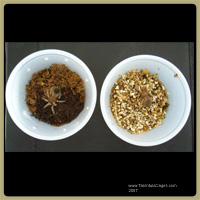
In general, you will want to use a substrate fit for the needs or your tarantula. Burrowers will need a substrate with a texture that will stay compacted, so that it will not cave in over time. Tropical species need a substrate that will retain moisture for ample humidity.
Overall, I prefer horticultural vermiculite because it is sterile, permanent, odorless and non-toxic. It has the highly desirable characteristic of being lightweight and the capability of good moisture retention.
The amount of substrate is dependent on the species and size of the container. Typically you can fill the container 2/3 full for burrowing terrestrial species and 1/3 full for arboreals. Not enough substrate won't allow for digging or retaining the proper level of humidity.
Furnishings
My favored furnishings are cork bark and sphagnum moss.Both offer a natural look and provide a secure area for your tarantula to hide. For terrestrial tarantulas, just place a slightly concave piece of cork bark for them to hide under. Use a flat piece of bark against the back wall or corner of the cage for arboreal setups. Sphagnum moss is great for looks and allows spiderlings to hide in it.
WATERING AND HUMIDITY
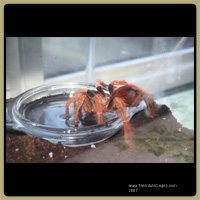
Providing water for your tarantula is a very easy, yet crucial part of their care. Care must be taken to avoid over watering or under watering your spider's container. Wet conditions promote fungal and bacteria growth. Under watering can cause desiccation or drying out.
To give water to spiderlings, simply use a spray bottle to mist one side of the substrate and let it soak in. Spiderlings will drink water droplets from the side of the container or from the dampened substrate. Larger tarantulas will need a small bottle cap or dish to drink from. Adding clean stones to the dish will allow crickets or other prey from drowning in the dish. Make sure you clean the water dish if it appears to be dirty.
Humidity is regulated by the amount of water you introduce to the cage, as well as the amount of ventilation. For dry climate species, simply provide a dish of water to drink from. There is no need to moisten their substrate unless they are smaller than 1". For tropical species that require more humidity, simply keeping the substrate slightly moistened and regularly misting the cage will keep the humidity up, and the tarantula will also drink beads of water from the walls of the cage. Always provide a water dish even if you use misting to provide water.
FEEDING

When you first receive your tarantula, don't try to feed it right away. Most likely it has had a meal recently and will not starve to death immediately. Let your tarantula get its bearings and settle in after a day or two before offering it a meal.
Tarantulas feed on insects and other invertebrates. Common prey items include crickets, mealworms, fruit flies and roaches. Crickets are the primary staple diet in captivity. They can be bought locally from a pet store or online through various cricket farms. If you have only a single or small number of tarantulas, the best route is to buy them from a local pet store. If you have a larger collection, plan on buying them in bulk from a cricket farm. Some hobbyists breed and raise their own cricket supply. Keeping the crickets alive can be researched by reading about them online.
When you're ready to offer your tarantula food, you must select the proper sized prey. As a rule, you should feed them items that about half their size or smaller. Spiderlings will usually start on a diet of 1/8" or pinhead crickets. Such small crickets usually have to purchased online, since most pet shops only carry larger crickets. You may also cut crickets into smaller "bite size" portions for very small spiderlings. They will still consume the dead prey as long as the spider can find it. 2" or larger tarantulas will eat adult crickets, mealworms and roaches.
The frequency and amount of feeding depends on the current size of your tarantula and how fast you want your tarantula to grow. Typically, a tarantula can eat about 2 to 3 crickets at a time. Growing spiderlings will need to be fed twice a week, and more mature tarantulas should be fed at least once a week.
If your spider refuses prey or retreats from it, the prey may be too large or the spider is approaching a molt. Try choosing smaller prey or remove it altogether if the spider is showing signs of a molt. If uneaten prey is not removed, it may die and create an unsanitary environment and can also be dangerous to your tarantula while it is molting. Crickets can even kill your vulnerable tarantula while it is molting, so always remove uneaten prey items.
MOLTING
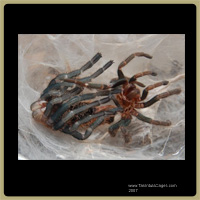
Molting is the process in which your tarantula grows out of its old exoskeleton, allowing its newly formed, larger body to emerge. Molting renews all bodily tissues, including the inside linings of their internal organs! They also will regenerate any lost limbs over time. The signs that indicate a molt are darker coloration, lowered activity, plump abdomen, and refusal of food.
When a tarantula approaches a molt, it may not eat for at least a week prior to the molt. Remove all uneaten prey items within 24 hours of introduction. Prey items left with a molting tarantula can cause stress and have been known to injure or even kill them. Be sure that you are maintaining proper humidity levels if your tarantula is approaching a molt. If your tarantula is a species that requires less humidity, then you should mist one corner of its enclosure to insure adequate humidity for an easier molt. Your tarantula will be on its back during the molting cycle. Do not become alarmed, it is not dead. Do not disturb or feed your tarantula for at least three days after molting. It takes several days for baby tarantulas to harden up and to regain their normal color and mobility after molting. Adults can take weeks.
READ UP!
Do not consider this general care sheet as the only source of information to care for your tarantula. All species require individual care needs and deserve the proper attention. There are many books and loads of information on the internet. Additionally, though methods of caring for your tarantulas are subject to personal opinions and preferences, you should beware of inaccurate suggestions or advice from self proclaimed experts or pet shops. This hobby can be very rewarding if you educate yourself about the animal you are going to care for.
QUESTIONS? Contact Me
|